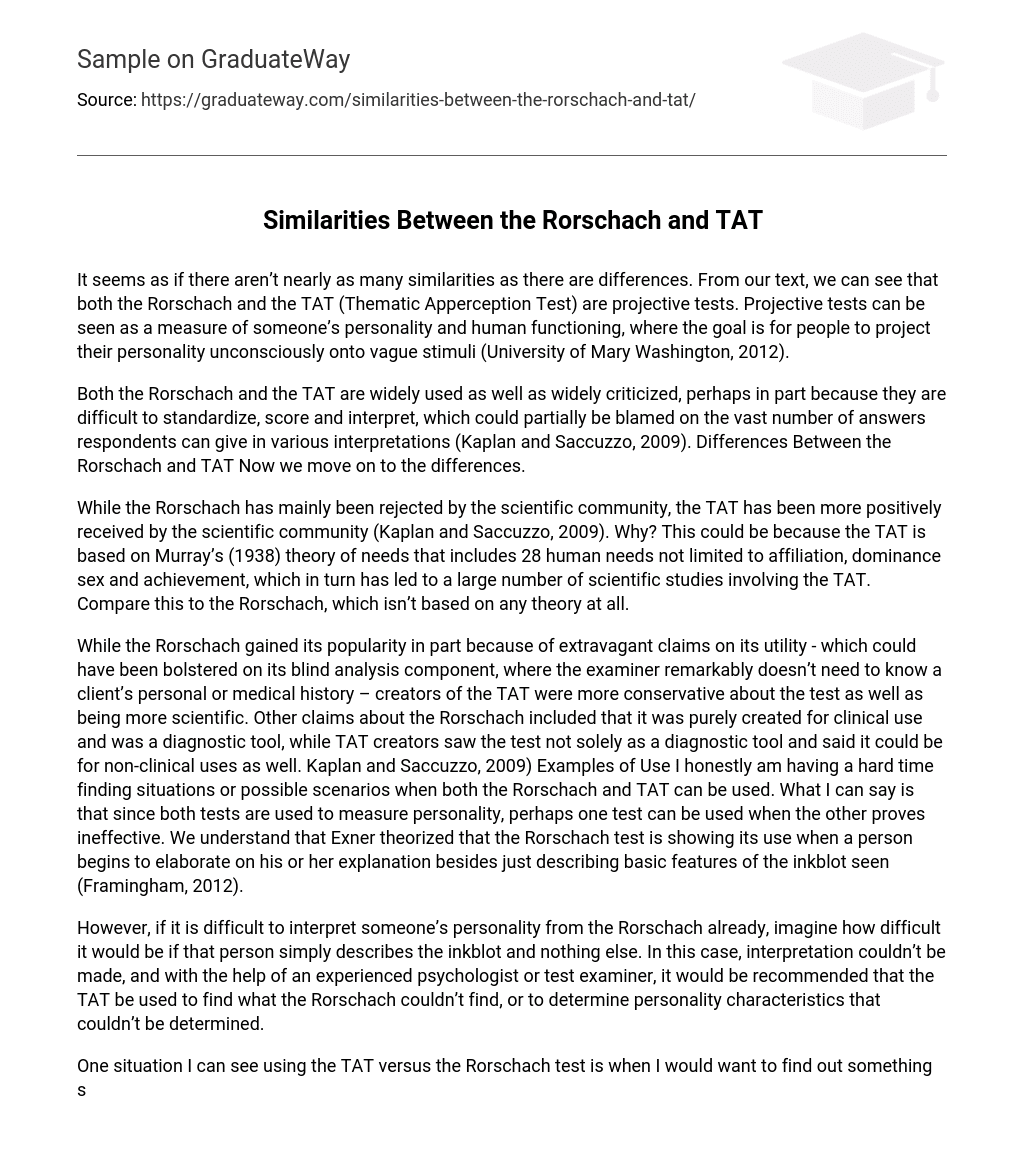It seems as if there aren’t nearly as many similarities as there are differences. From our text, we can see that both the Rorschach and the TAT (Thematic Apperception Test) are projective tests. Projective tests can be seen as a measure of someone’s personality and human functioning, where the goal is for people to project their personality unconsciously onto vague stimuli (University of Mary Washington, 2012).
Both the Rorschach and the TAT are widely used as well as widely criticized, perhaps in part because they are difficult to standardize, score and interpret, which could partially be blamed on the vast number of answers respondents can give in various interpretations (Kaplan and Saccuzzo, 2009). Differences Between the Rorschach and TAT Now we move on to the differences.
While the Rorschach has mainly been rejected by the scientific community, the TAT has been more positively received by the scientific community (Kaplan and Saccuzzo, 2009). Why? This could be because the TAT is based on Murray’s (1938) theory of needs that includes 28 human needs not limited to affiliation, dominance sex and achievement, which in turn has led to a large number of scientific studies involving the TAT. Compare this to the Rorschach, which isn’t based on any theory at all.
While the Rorschach gained its popularity in part because of extravagant claims on its utility – which could have been bolstered on its blind analysis component, where the examiner remarkably doesn’t need to know a client’s personal or medical history – creators of the TAT were more conservative about the test as well as being more scientific. Other claims about the Rorschach included that it was purely created for clinical use and was a diagnostic tool, while TAT creators saw the test not solely as a diagnostic tool and said it could be for non-clinical uses as well. Kaplan and Saccuzzo, 2009) Examples of Use I honestly am having a hard time finding situations or possible scenarios when both the Rorschach and TAT can be used. What I can say is that since both tests are used to measure personality, perhaps one test can be used when the other proves ineffective. We understand that Exner theorized that the Rorschach test is showing its use when a person begins to elaborate on his or her explanation besides just describing basic features of the inkblot seen (Framingham, 2012).
However, if it is difficult to interpret someone’s personality from the Rorschach already, imagine how difficult it would be if that person simply describes the inkblot and nothing else. In this case, interpretation couldn’t be made, and with the help of an experienced psychologist or test examiner, it would be recommended that the TAT be used to find what the Rorschach couldn’t find, or to determine personality characteristics that couldn’t be determined.
One situation I can see using the TAT versus the Rorschach test is when I would want to find out something specific. Yes, both tests are used to measure someone’s personality, but let’s assume the following situation takes place: a mother of an 8 year old son named Jack wants to find out what it is about Jack that makes him unable to stay in the classroom, stay at music lessons or stay in the playground while crying out for his mother. She wants to know if this could be a personality issue or at least what it says about Jack.
The Rorschach test provides images that could be too complicated for Jack to interpret in addition to the fact that Jack could be so overwhelmed by confusion by it that his answers will continue to linger on. Compare this to the TAT, which could present Jack with images of familiar situations, say a child playing in a playground or a person playing the piano while looking excited. What will Jack say in response to these images? Only the test will tell but I can see a greater chance of Jack being able to tell a story rather than the Rorschach test where he may simply just be trying to describe the inkblot seen in front of him.
Value of Projection Tests We have all read and heard by now that projection tests have validity issues, they may not always provide accurate interpretations and their scoring systems are sometimes seen as unreliable. In fact, the notion that the Rorschach and TAT aren’t standardized is a huge problem since it might take a variety of clinicians to make it effective for one client. Despite this, I see value in projection tests because of their uniqueness.
I see these tests as accurate because they allow the examinee to tell a story based on a series of images, they can relate to the image in a variety of ways and to a certain extent, because examiners are recording every single detail of a response, not just every word and the way the word is thought or constructed, but also the reaction time, there can be a lot more learned about someone with these tests versus a structured personality test. Can a person better relate to a structured personality test that consists of True/False items?
My belief tells me no, though I acknowledge that far more research needs to be done. I also acknowledge that the Rorschach and TAT’s inability to be consistently measured or standardized is a problem. It’s a problem that can lead to certain issues, such as over diagnosing emotional disorders that truly don’t exist. But, as mentioned in our text among other authors, if an experienced examiner is brought in to work with an examinee and I believe that if a TAT is used as opposed to the Rorschach, some progress can be made in determining someone’s personality.





